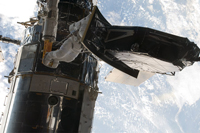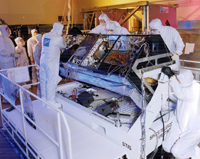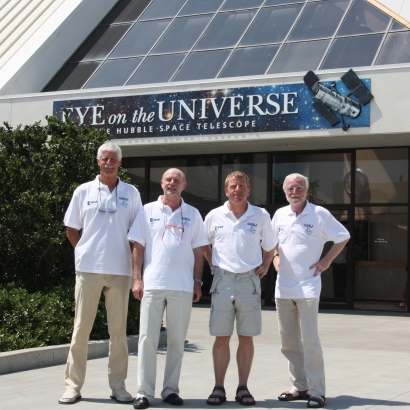Hubble Servicing Mission SM4
Status Report #5
Servicing Mission accomplished – it's a success!
Following the successful completion of five days of EVA refurbishment/repair activities for HST, the telescope has been released into orbit by the grapple fixture of the Atlantis Remote Manipulator System.
 |
|
Preparing to install the WFPC3 during SM4. Credit: NASA |
In spite of not having been designed for in-orbit maintenance, the challenging tasks of repairing some of Hubble’s scientific instruments were successfully completed. Success has been achieved due to the versatility of humans in space and by the use of many new tools specifically developed for these repair tasks.
However, space hardware always carries the potential for surprises. In one case, attempts to remove a bolt on a handrail showed no prospect for success, even using all of the tools that were available to the astronaut. Supported by real time on-ground validation of the required forces, the astronaut eventually had to apply "brute force" to remove the handrail by breaking off the bolt. Had this "drastic" approach not been taken the handrail would have obstructed the placement of the STIS repair tool.
 |
|
The STIS during its construction in 1996. Credit: NASA |
The successful replacement and in-orbit functional validation testing of the following HST subsystems/units provides operational capabilities for many years, potentially extending the HST in-orbit life towards 2020:
- The old batteries have been replaced by new modules;
- Of the three rate sensor units (RSU), two new ones have been installed and one refurbished unit has been implemented since a new unit would not fit in place;
- The Science Data Handling & Control unit, of which the primary channel had failed shortly before the initially scheduled SM4 launch, has been replaced by a new unit;
- One of the three Fine Guidance Sensor (FGS) units - the FGS2 - has been replaced;
- Three large surface areas, where the MultiLayer Insulation (MLI) had severely degraded over the 19 years in orbit, have been replaced by panel type thermal insulation. Originally, only two replacements were scheduled, however, the astronauts proved to be quick in completing the tasks of the last EVA day and could accommodate a third area replacement. The removal during the EVA of the crippled MLI proved to be tricky, with some pieces free-floating into space.
In addition to these replacement tasks, the HST has been equipped at the berthing side with a new soft-capture and docking interface. This device will be used for the possible de-orbiting of the HST when it has completed its mission by providing a suitable interface for autonomous docking by a propulsion or de-orbiting spacecraft.
At several stages during the mission the EVA tasks appeared almost a "mission impossible", however, the ingenuity of the supporting teams on ground in combination with the versatility of the astronauts led in each case to solutions being found to the problems experienced. The ESA HST team at the GSFC STOCC supported their NASA colleagues efficiently in all tasks related to the ESA hardware, the SADM and SADE. As anticipated, substantial solar array slippages have occurred during the EVA tasks. Where necessary, corrective actions have been commanded in order to maximize the time available for EVA activities.
The great cooperation in this ESA/NASA Hubble mission has been a rewarding experience for all team members. This joint team is a real A1-team and the many years of SM4 mission preparations, including the development of contingency procedures, has paid off. SM4 has been completely successful and expectations have even been exceeded.
Hubble has now been successfully released into orbit for a new life promising many scientific discoveries. Equipped with new eyes representing most advanced detector capabilities, a new “brain”, stabilisation units and shiny new clothes, replacing some worn dressing, the telescope appears as a newborn star in orbit.
The ESA HST team bids farewell to Hubble and wishes it good luck! And the team looks forward to the safe return to Earth, on board Atlantis, of these great astronauts!
PS: The ESA HST team will follow the Hubble operations until the first solar array slews have been successfully completed on the in-orbit released telescope.
Prepared by Michael Eiden, 19 May 2009
Editor's note: The ESA HST team provides engineering support for the ESA hardware on the HST: the two Solar Array Drive Mechanisms (SADM), the Solar Array Drive Electronics (SADE), and the Drive Control Electronics (DCE).
The team comprises Michael Eiden (ESA HST Project Manager) and Lothar Gerlach from the technical directorate at ESA, and Udo Rapp and Manfred Schmid from EADS Astrium.
 |
|
The ESA HST support team prior to the start of servicing mission 4. From left to right: Manfred Schmid, Michael Eiden, Udo Rapp and Lothar Gerlach. Credit: ESA |

